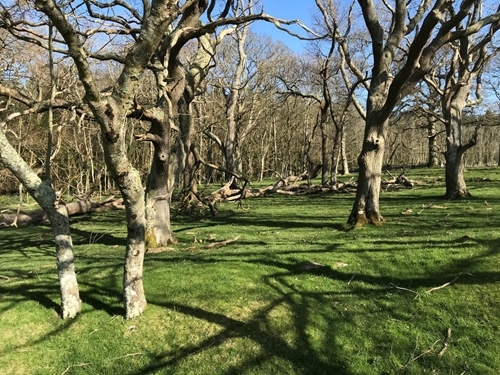By Sue Evans, Director GWCT Cymru
4 Minute Read

Welsh Government are really keen to plant thousands of hectares of trees in Wales. The drive to plant trees to sequester carbon raises the potential conflict between carbon and biodiversity and at present it seems that carbon trumps biodiversity. In the news today there is talk of the need for biodiversity targets which could even up the playing field between the two.
One of our farming members Hywel, seems to have similar concerns writing to me recently he said “Would like some help and advice. On our mountain just above the farm we are seeing lots of curlews last couple of years not sure if they’ve always been around here maybe I’m just noticing them more. I see anything from one to 7 regular. We have crazy amounts of skylarks at moment. Anyway, adjoining the mountain is a block of land that’s just coming up for sale first time in a few generations. The land is very mountain like and hasn’t been touched by a plough for 65-70 years or maybe more. My concern is that there be tree planting investors looking to buy and destroying the habitat and biodiversity and some peat bogs. The cuckoo has always sung from there every year as long as I can remember. How can we deter wood planting city slickers from purchasing this land and changing the appearance of the hills for ever for the sake of some rich people’s pensions???”
Looking at the science it seems to me that the planting of trees is not the only method to sequester carbon on farms and grass covered organic soils should be measured for their contribution to carbon sequestration on farm. As I wrote in our response to the Agriculture (Wales) White Paper Consultation, when looking at tree planting for the sequestration of carbon there are two recent scientific studies which highlight how tree planting may not be the best option to increase carbon sequestration on farmland.
A new piece of research published March 24 in Nature, “A trade-off between plant and soil carbon storage under elevated CO2” explains how grassy ecosystems with very few trees are also important for storing carbon in soil. This is because tree planting in organic soils does not result in net carbon sequestration on decadal timescales. It suggests that when elevated carbon dioxide levels drive increased plant growth, it takes a surprisingly steep toll on another big carbon sink: the soil.
One likely explanation, the authors say, is that plants effectively mine the soil for nutrients they need to keep up with carbon-fuelled growth. Extracting the extra nutrients requires revving up microbial activity, which then releases CO2 into the atmosphere that might otherwise remain locked in soil.
The research suggests grasslands may absorb unexpectedly large amounts of carbon in the coming decades. Under a scenario where atmospheric CO2 doubles pre-industrial levels the researchers estimate carbon uptake in grassland soils will increase 8 percent, while carbon uptake by forest soils will remain roughly flat. That's in spite of CO2 enrichment giving a greater boost to biomass in forests (23 percent) than in grasslands (9 percent), partly because trees allocate below ground a relatively small portion of the carbon they absorb "From a biodiversity point of view, it would be a mistake to plant trees in natural grassland and savanna ecosystems," The lead author, César Terrer said. "Our results suggest these grassy ecosystems with very few trees are also important for storing carbon in soil."
As tree planting can potentially have a great positive or negative effect on biodiversity it is of paramount importance that tree planting is done in the right places. We believe that there is great opportunities for small scale planting on farms which can provide great benefit to biodiversity as well as carbon. We would also like other forms of carbon capture on farm recognised and funded in the same way as the developing markets withing the woodland and peatland carbon codes.
Policy and regulation based on best Scientific Evidence is crucial. We really need to know that policy and regulation is based on the latest and best scientific evidence which is constantly changing as research continues to increase our understanding. Future policy and regulation should be adaptable to be able to take into account the change necessary as identified through our scientific understanding.
Additional Reading:
March 24 in Nature, A trade-off between plant and soil carbon storage under elevated CO2